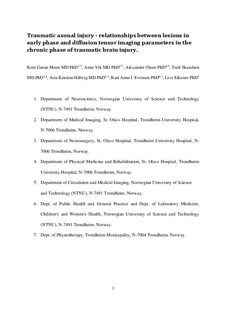| dc.contributor.author | Moen, Kent Gøran | |
| dc.contributor.author | Vik, Anne | |
| dc.contributor.author | Olsen, Alexander | |
| dc.contributor.author | Skandsen, Toril | |
| dc.contributor.author | Håberg, Asta | |
| dc.contributor.author | Evensen, Kari Anne Indredavik | |
| dc.contributor.author | Eikenes, Live | |
| dc.date.accessioned | 2016-10-07T12:15:53Z | |
| dc.date.accessioned | 2016-10-10T11:51:48Z | |
| dc.date.available | 2016-10-07T12:15:53Z | |
| dc.date.available | 2016-10-10T11:51:48Z | |
| dc.date.issued | 2016 | |
| dc.identifier.citation | Journal of Neuroscience Research 2016, 94(7):623-635 | nb_NO |
| dc.identifier.issn | 0360-4012 | |
| dc.identifier.uri | http://hdl.handle.net/11250/2413939 | |
| dc.description.abstract | This prospective study of traumatic brain injury (TBI) patients investigates fractional anisotropy (FA) from chronic diffusion tensor imaging (DTI) in areas corresponding to persistent and transient traumatic axonal injury (TAI) lesions detected in clinical MRI from the early phase. Thirty-eight patients (mean 24.7 [range 13–63] years of age) with moderate-to-severe TBI and 42 age- and sex-matched healthy controls were included. Patients underwent 1.5-T clinical MRI in the early phase (median 7 days), including fluid-attenuated inversion recovery (FLAIR) and T2* gradient echo (T2*GRE) sequences. TAI lesions from the early phase were characterized as nonhemorrhagic or microhemorrhagic. In the chronic phase (median 3 years), patients and controls were imaged at 3 T with FLAIR, T2*GRE, T1, and DTI sequences. TAI lesions were classified as transient or persistent. The FLAIR/T2*GRE images from the early phase were linearly registered to the FA images from the chronic phase and lesions manually segmented on the FA-registered FLAIR/T2*GRE images. For regions of interest (ROIs) from both nonhemorrhagic and microhemorrhagic lesion, we found a significant linear trend of lower mean FA from ROIs in healthy controls to ROIs in patients without either nonhemorrhagic or microhemorrhagic lesions and further to transient and finally persistent lesion ROIs (P < 0.001). Histogram analyses showed lower FA in persistent compared with transient nonhemorrhagic lesion ROIs (P < 0.001), but this was not found in microhemorrhagic lesion ROIs (P = 0.08–0.55). The demonstrated linear trend of lower FA values from healthy controls to persistent lesion ROIs was found in both nonhemorrhagic and microhemorrhagic lesions and indicates a gradual increasing disruption of the microstructure. Lower FA values in persistent compared with transient lesions were found only in nonhemorrhagic lesions. Thus, clinical MRI techniques are able to depict important aspects of white matter pathology across the stages of TBI. | nb_NO |
| dc.language.iso | eng | nb_NO |
| dc.publisher | Wiley | nb_NO |
| dc.title | Traumatic axonal injury: Relationships between lesions in the early phase and diffusion tensor imaging parameters in the chronic phase of traumatic brain injury | nb_NO |
| dc.type | Journal article | nb_NO |
| dc.type | Peer reviewed | nb_NO |
| dc.date.updated | 2016-10-07T12:15:53Z | |
| dc.source.volume | 94 | nb_NO |
| dc.source.journal | Journal of Neuroscience Research | nb_NO |
| dc.source.issue | 7 | nb_NO |
| dc.identifier.doi | 10.1002/jnr.23728 | |
| dc.identifier.cristin | 1372541 | |
| dc.description.localcode | © 2016 Wiley Periodicals, Inc. This is the authors' accepted and refereed manuscript to the article. Locked until 2017-03-06 due to copyright restriction. | nb_NO |
